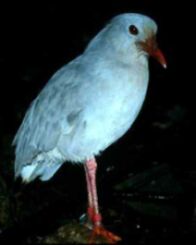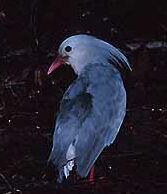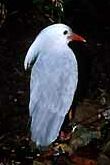



Scientific Name: Rhynochetos jubatus | Current Range: South Pacific Ocean - New Caledonia

The kagu is the only member of the family Rhynochetidae. Resembling a short heron, it is actually related to the rails. It is 22 to 24 inches long, slate to ash gray, with black, red, and white bars on the flight feathers. It s legs and bill are orange-red and it has a long, tufted crest. Essentially flightless and ground-dwelling, its short wings are used more for courtship display than for flight. It probes the ground with its large bill for worms, grubs, snails, and other invertebrates. A nocturnal bird, its strong, yelping call can be heard mostly at night. Predators include those introduced by humans: rodents, pigs, cats, and dogs.
During courtship displays, the kagu extends its wings, fanning them to show the barred pattern, and raises its crest. A single, pale colored egg with brown and gray spots is incubated by both parents for 36 days. The chick becomes independent after nine to fourteen weeks.

The kagu is found only in New Caledonia, both in valleys of the central mountain range and in northern forest, where it dwells in dense forest and brush. Population is estimated at 500 to 1,000 birds.
For centuries the untouched forests of New Caledonia sheltered unique species which evolved to fit their secluded and protected environment. The kagu, lacking natural predators, has been severely impacted by introduced ones such as rodents, pigs, cats, and dogs.

In addition to the threat of these predators, the kagu is suffering from loss of habitat. It was once plentiful throughout New Caledonia, but is now restricted to those areas that are least accessible to humans. Forests throughout New Caledonia are being destroyed rapidly for timber, agriculture, and nickel mining.
The kagu has been bred in captivity; it is prized by zookeepers and is a popular pet.
This page hosted by  Get your own Free Home Page
Get your own Free Home Page













